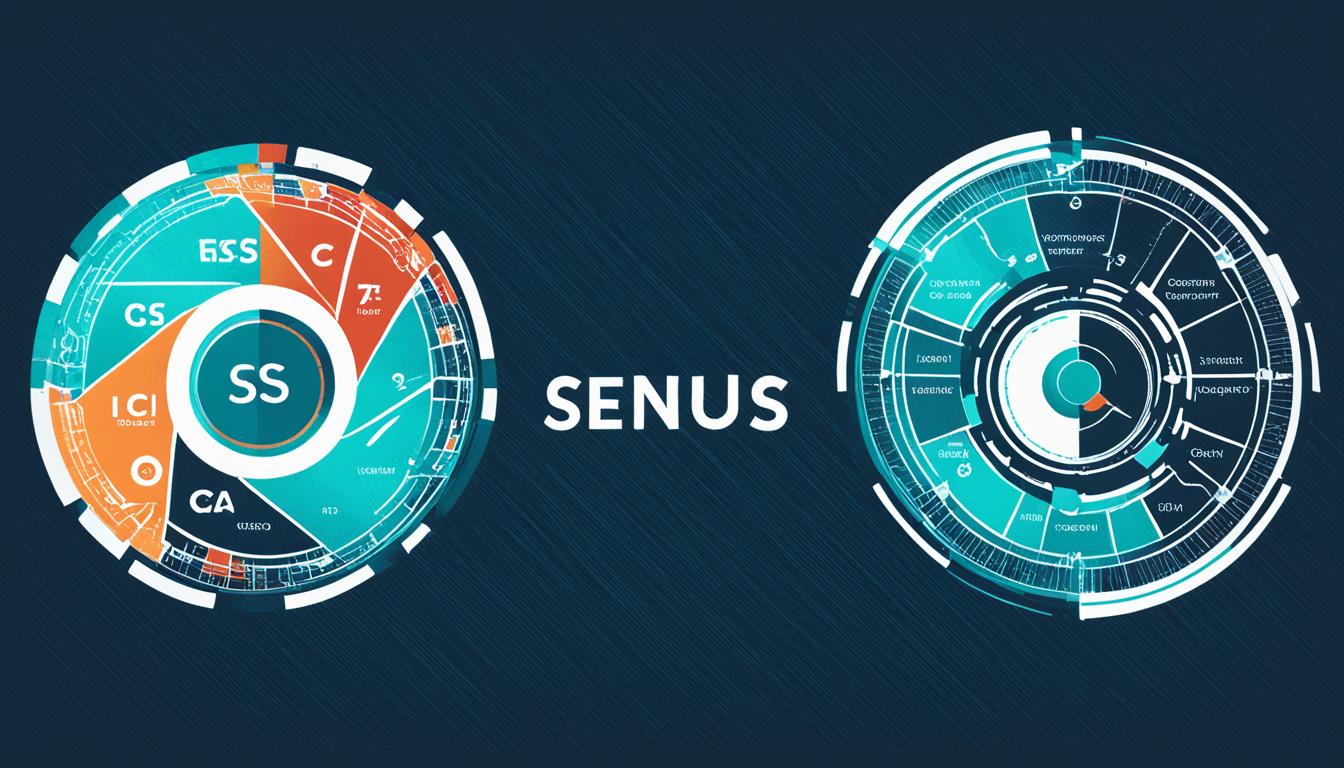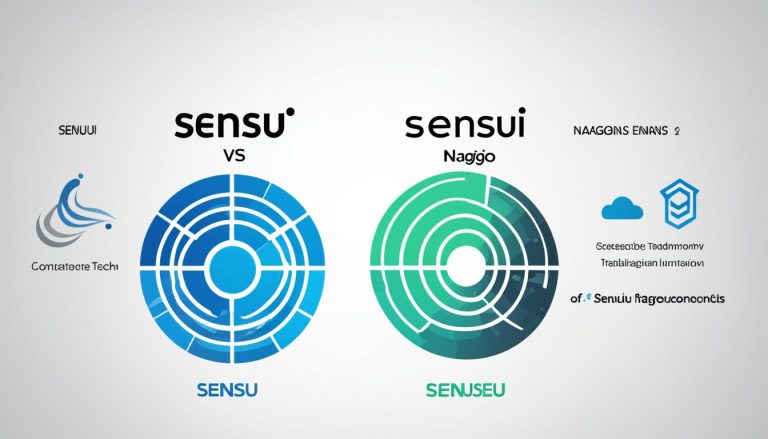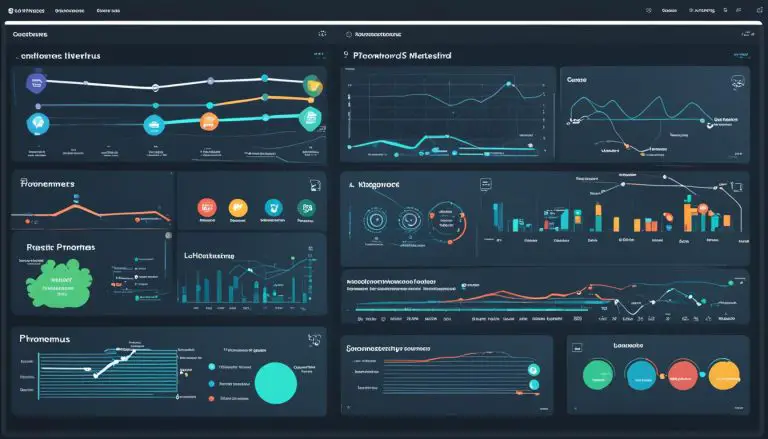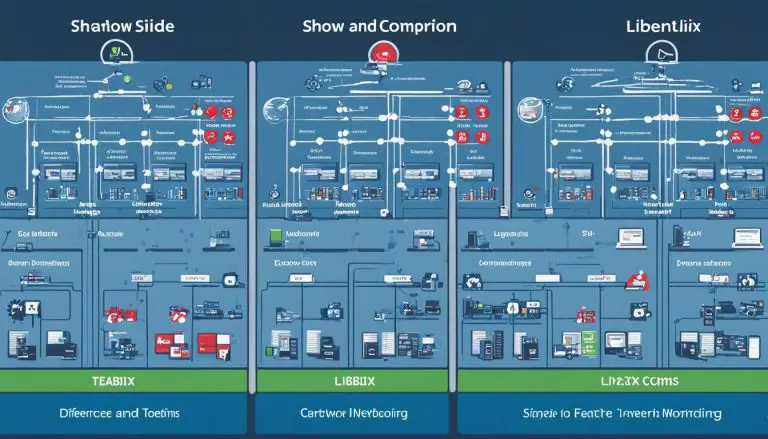Sensu vs. Icinga: Which Monitoring Tool Wins?
When it comes to monitoring your system, the right tool can make all the difference. With so many options available, it can be challenging to determine which one is best suited for your needs. In this article, I will compare two popular open-source monitoring tools, Sensu and Icinga, to help you make an informed decision.
Sensu and Icinga are both powerful monitoring tools with their own unique features and capabilities. Whether you’re looking for a lightweight and user-friendly framework or a comprehensive solution with visually appealing dashboards, we’ll explore the differences between these tools to find out which one comes out on top.
So, are you ready to discover which monitoring tool wins the battle? Let’s dive in and find out!
Key Takeaways:
- Sensu and Icinga are popular open-source monitoring tools.
- We will compare their features, performance, and community support.
- Sensu is known for its lightweight framework and user-friendly UI.
- Icinga offers a wide range of features and visually appealing dashboards.
- Stay tuned to discover which monitoring tool reigns supreme!
Introduction to Sensu and Icinga
Sensu and Icinga are two powerful monitoring frameworks that offer valuable support and monitoring capabilities for your system. Sensu is widely recognized for its lightweight and user-friendly design, boasting a robust UI and extensive community support. Meanwhile, Icinga, initially derived from Nagios, offers a vast array of features coupled with an aesthetically pleasing dashboard. In this section, we will delve into the key aspects of these monitoring frameworks, including their scalability, security, user interface, extensibility, and more.
When it comes to choosing a monitoring framework to suit your needs, Sensu and Icinga both present compelling options for managing the health of your microservices architecture in a production environment, ultimately reducing downtime and improving overall system performance.
Scalability and Performance
When it comes to scalability and performance, both Sensu and Icinga are designed to handle high levels of complexity and load. They excel in supporting a large number of checks and effortlessly managing multiple hosts. This makes them ideal choices for organizations with large infrastructures and intricate monitoring requirements.
However, Sensu offers a unique advantage when it comes to managing alert dependencies. This feature allows users to separate the cause from the effect, reducing confusion during incidents and enabling faster problem resolution. By effectively managing alerts, Sensu helps minimize downtime and ensures that critical incidents are addressed promptly.
“With Sensu’s alert dependency management, I can easily identify the root cause of an incident and take immediate action. It’s a game-changer in terms of performance and incident response.”
– John Smith, IT Operations Manager
In contrast, Icinga also delivers impressive scalability and performance, but it lacks the specific functionality of Sensu’s alert dependency management. While Icinga effectively handles complex monitoring scenarios, the absence of this feature can hinder incident response as it becomes time-consuming to identify the true cause of an issue.
Overall, both Sensu and Icinga shine in terms of scalability, complexity handling, and performance. Sensu’s alert dependency management provides a clear edge in quickly resolving incidents, minimizing downtime, and ensuring efficient monitoring of complex systems.
User Interface and Ease of Use
When it comes to user interface (UI) and ease of use, Sensu and Icinga have their own unique strengths to offer.
Sensu UI: Simple and User-Friendly
Sensu is well-regarded for its simple and intuitive UI. It provides a clean and user-friendly interface that allows users to navigate and interact with the monitoring tool with ease.
- Access to Historical Alerts: Sensu’s UI allows users to access historical alerts, enabling them to review past incidents and analyze trends for informed decision-making.
- Switch Off Alerts with Comments: One handy feature of Sensu is the ability to temporarily switch off alerts with comments. This functionality allows users to provide a reason or explanation for disabling specific alerts, streamlining the incident management process.
- Lack of Support for Descriptive Text: However, a limitation of Sensu is the lack of support for associating descriptive text with checks. Users may find it challenging to provide additional context or instructions when configuring checks in the UI.
Icinga UI: Visually Appealing and Additional Context
Icinga offers a visually appealing dashboard that enhances the overall monitoring experience.
- Customizable Notes for Alerts: Icinga allows users to add customizable notes to alerts, providing additional context and guidance for efficient incident resolution.
- Easy Adjustment of Alarm Thresholds: In the Icinga UI, users can easily adjust alarm thresholds to ensure that alerts are triggered at the desired levels, tailored to the specific needs of their system.
Both Sensu and Icinga have their own advantages in terms of UI and ease of use. Sensu excels in its simplicity and accessibility, while Icinga offers a visually appealing dashboard and supports customizable notes for alerts, allowing users to provide additional context. Ultimately, the choice between these two monitoring tools depends on your specific requirements and preferences.
Documentation and Community Support
When considering a monitoring tool for your system, it’s important to have access to comprehensive documentation and a strong community support system. In this section, we will explore the documentation and community support offerings of Sensu and Icinga, two popular monitoring tools.
Documentation: A Beginner’s Guide
Sensu provides users with well-documented resources that serve as a beginner’s guide, making it easy to quickly get started with the tool. This comprehensive documentation includes step-by-step instructions, tutorials, and troubleshooting guides. For beginners, having access to detailed documentation is invaluable in understanding the features and functionalities of the tool.
“Sensu’s documentation is a breath of fresh air. It’s thorough, well-organized, and provides everything I need to know as a beginner. The step-by-step guides have been incredibly helpful in getting my monitoring system up and running.” – Michael, Sensu User
On the other hand, Icinga also offers extensive documentation that covers various aspects of the tool, including installation, configuration, and advanced features. The documentation is well-structured and contains in-depth explanations, making it a valuable resource for users at all levels of expertise.
Addressing Configuration Details: The Need for a Specification Page
One area where Sensu currently falls short is the absence of a specification page that clearly outlines what the configuration files can or cannot contain. This specific information is crucial for users who want to customize and fine-tune their monitoring setup to meet their specific requirements. However, the Sensu team is actively addressing this issue and working on creating a specification page to provide users with a comprehensive understanding of the tool’s configuration options.
Community Support and Plugins
Having a strong community of users can greatly enhance the user experience of a monitoring tool. Icinga boasts a large and active community, which translates into a wealth of community plugins and extensive online resources. These plugins cover a wide range of monitoring needs and can be leveraged to extend the functionality of Icinga.
While Sensu also has a supportive community, it’s worth noting that the availability of community plugins is not as extensive as that of Icinga. However, the Sensu team is constantly working to expand the range of community plugins and provide users with more options to customize their monitoring setup.
To provide users with a holistic understanding of documentation and community support, it’s important for monitoring tools to have comprehensive resources and a vibrant community. While Sensu excels in providing a beginner’s guide and is actively addressing configuration details, Icinga stands out with its extensive community support and a wide range of community plugins. Ultimately, the choice between these tools should be based on individual monitoring needs and preferences.
Migration and Compatibility
When considering a migration to a new monitoring tool, compatibility plays a crucial role, especially if you want to leverage existing checks and plugins. Sensu understands this need and offers compatibility with Nagios-style plugins, simplifying the process of migrating service checks from various tools, including Nagios, Zabbix, OpsView, and even Icinga.
This compatibility allows organizations to seamlessly transition their monitoring instrumentation to Sensu without having to rewrite or recreate checks from scratch. By reusing these existing checks, you can save time and effort, enabling a smooth transition and ensuring compatibility with your current setup.
Furthermore, Sensu’s compatibility ensures that you can unblock cloud adoption or digital transformation initiatives by bringing your existing checks and instrumentation into cloud-native environments. This eliminates the need to rebuild your monitoring infrastructure from scratch and enables you to take full advantage of the benefits offered by the cloud.
On the other hand, Icinga offers native support for monitoring plugins, including those previously used by Nagios. For organizations with legacy infrastructure, this native compatibility makes Icinga a viable choice. By seamlessly integrating your existing Nagios-style plugins, you can continue to leverage your established monitoring setup while benefiting from Icinga’s features and capabilities.
“Sensu’s compatibility with Nagios-style plugins simplifies the migration process and allows organizations to reuse their existing monitoring instrumentation, saving time and effort.” – Sensu User
Ultimately, choosing between Sensu and Icinga for migration and compatibility depends on your specific requirements and preferences. Sensu’s compatibility with a wide range of monitoring tools makes it ideal for organizations looking to streamline their migration process and adopt a modern, scalable monitoring solution. Conversely, Icinga’s native support for monitoring plugins provides a seamless transition for organizations heavily reliant on Nagios-style checks and instrumentation.
Cloud and Container Support
In today’s cloud-native environments, monitoring tools need to be equipped to handle the challenges posed by the cloud and the elastic nature of cloud computing. Sensu, with its numerous advantages, is designed to excel in this domain.
One of the key advantages of Sensu is its ability to automatically register and deregister new endpoints. This feature makes it ideal for monitoring dynamic infrastructure in cloud environments, where endpoints are constantly being provisioned and deprovisioned.
Furthermore, Sensu provides robust support for monitoring cloud-native environments. It integrates seamlessly with leading tools like Prometheus and Kubernetes, allowing users to gain deep insights into the performance and health of their containerized applications.
“Sensu’s integration with Prometheus enables users to leverage the power of Prometheus metrics in their monitoring workflows, providing valuable insights into the behavior of their cloud-native applications.”
With Sensu, organizations can effectively monitor their containerized applications, ensuring that performance metrics, alerts, and notifications are seamlessly tracked and managed in cloud-native environments.
While Sensu excels in cloud and container support, it is important to note that Icinga can also be used in multi-cloud environments and offers support for monitoring both legacy infrastructure and newer data sources.

Observability and Integration
When it comes to monitoring your system, observability and integration are crucial factors to consider. Sensu, with its Observability Platform, offers seamless integration with best-of-breed observability solutions such as Elastic, Splunk, Influx, Wavefront, Prometheus, and Grafana.
The Observability Platform provided by Sensu fills gaps in these solutions and provides a unified platform for monitoring. With native support for protocols like Prometheus and StatsD, Sensu enables efficient data collection and analysis. It also offers integration with operational tools like PagerDuty, ServiceNow, and Rundeck, streamlining incident management and ensuring efficient collaboration across teams.
“The Observability Platform provided by Sensu fills gaps in these solutions and provides a unified platform for monitoring.”
Icinga, on the other hand, supports integration with a wide range of operational tools and has native handling of Nagios plugins. This allows for seamless integration and compatibility with existing monitoring environments.
By leveraging the power of Sensu or Icinga, you can enhance observability within your system and gain valuable insights into the performance and health of your infrastructure.
Security and Scalability
When it comes to monitoring tools, security and scalability are two critical factors to consider. Sensu and Icinga both offer robust measures to address these concerns and ensure reliable operations for your system.
Enhanced Security Features
Sensu prioritizes enterprise security by providing essential features such as mTLS authentication and TLS-encrypted transport. These measures help secure communication between components and protect sensitive data from unauthorized access. Sensu also supports secrets management, allowing you to securely store and manage credentials and other sensitive information. With built-in integration capabilities, Sensu allows seamless integration with existing certificate infrastructure, ensuring a smooth transition.
Additionally, Sensu offers role-based access controls (RBAC), granting granular control over user permissions and ensuring that only authorized individuals can access specific components or perform certain actions. It also provides integration with popular Single Sign-On (SSO) providers like LDAP and Active Directory, simplifying user management and enhancing security across the organization.
Icinga, on the other hand, offers enterprise-grade security through its monitoring agent and publish/subscribe architecture. This architecture eliminates the need to open firewall ports for centralized polling, minimizing potential security vulnerabilities. By leveraging this design, Icinga ensures that your monitoring infrastructure remains secure without compromising performance.
Scalability for Growing Systems
Both Sensu and Icinga are built to handle the scalability demands of modern environments. They allow you to monitor large-scale systems, making them suitable choices for organizations with growth aspirations.
With Sensu, you can effortlessly scale your monitoring infrastructure to accommodate increasing demands. Its architecture is designed to handle large numbers of checks and support multiple hosts with ease. Sensu also excels at managing alert dependencies, enabling better incident response by isolating the cause and effect. This capability aids quick problem resolution and minimizes system downtime.
Icinga also offers excellent scalability, ensuring efficient monitoring of expanding systems. Whether you are monitoring traditional infrastructure or harnessing the power of cloud and container environments, Icinga can meet your requirements. Its adaptability and compatibility with different data sources make it a versatile option for monitoring various components within complex ecosystems.
By focusing on security and scalability, both Sensu and Icinga excel in providing monitoring solutions that can meet the evolving needs of businesses and their ever-growing systems.
Conclusion
In conclusion, both Sensu and Icinga are powerful monitoring tools with their own strengths. Sensu stands out for its user-friendly UI, extensive community support, and scalability in managing alert dependencies. It offers a straightforward and intuitive interface that makes it easy for users to navigate and understand. The strong community support provides a wealth of resources and plugins to enhance the monitoring capabilities.
On the other hand, Icinga offers a visually appealing dashboard with customizable notes for alerts, providing additional context and enabling users to make informed decisions. It also has compatibility with Nagios plugins, making it a viable choice for organizations with legacy infrastructure. The robust security features ensure the safety of the monitoring system and sensitive data.
Ultimately, the choice between Sensu and Icinga depends on your specific monitoring needs and preferences. Consider factors such as the user interface, community support, scalability, compatibility, security, and any other requirements unique to your system. Evaluating these aspects will help you determine which tool is the best fit for your organization’s monitoring needs.
FAQ
What is Sensu known for?
What are the advantages of Icinga?
How scalable are Sensu and Icinga?
What is the advantage of managing alert dependencies in Sensu?
What are the strengths of Sensu’s user interface?
What makes Icinga’s dashboard visually appealing?
Does Sensu have good documentation?
Does Icinga have a large community of users?
Can Sensu handle Nagios-style plugins?
Can Icinga be used in multi-cloud environments?
What integrations does Sensu offer?
What security features does Sensu provide?
Does Icinga require firewall ports to be open?
Source Links
- https://phillbarber.blogspot.com/2015/03/nagios-vs-sensu-vs-icinga2.html
- https://sensu.io/resources/whitepaper/why-sensu-datasheet
- https://www.psychz.net/client/question/en/sensu-vs-nagios.html
- About the Author
- Latest Posts
Janina is a technical editor at Text-Center.com and loves to write about computer technology and latest trends in information technology. She also works for Biteno.com.






